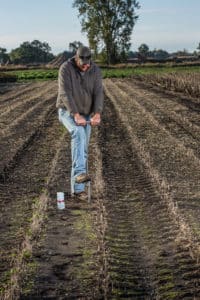It’s fall time. That means you’re likely thinking about cooler weather, the changing colors, falling leaves and… collecting a soil test.
While it may not be top of mind amidst the swarm of pumpkin spice, fall is an ideal time to test your soil’s nutrient contents. Don’t wait until the rush of spring planting to determine what nutritional components are missing or in the improper balance. Having a crop nutrition plan in place can help set the stage for the best yield ever in 2023.
Collecting a Soil Sample
Gathering samples for soil testing isn’t complicated but needs to be done with attention. It is important to ensure your soil test is an accurate representation of your entire field. When collecting soil follow these simple steps to get the best ROI and most accurate results.
- Pull samples in a zig-zag or grid pattern through the middle of the area.
- Pull separate soil samples for areas that show crop damage, different soil types, or different water absorption patterns. Each composite sample should not represent an area larger than 20 acres.
- Place the soil collected in a clean plastic bucket. Metal buckets or buckets used for other purposes can corrupt the sample.
- Send the soil samples to the lab using a testing bag. And be sure to include a completed submission form with your sample!
- Work with an agronomist to evaluate your results.
Reading and Interpreting Results
At first glance, a soil test report can look as daunting as the line at the store the day after Thanksgiving. However, when you break down each component, you can start to see the full picture of the condition of your soil. Organic matter percent, cation exchange capacity, pH and base saturation percent should all be included in your results and are key factors in understanding the chemical and physical characteristics of a soil. But, what do you do with all those numbers?
By looking at your soil’s percent organic matter, you can gauge the overall health of your soil and gain a rough estimate of naturally occurring nutrient release, like nitrogen, throughout the growing season.
The cation exchange capacity (CEC) denotes the nutrient-holding capacity of your soil. Understanding your soil’s CEC will give you an indication of when some nutrients should be applied. If CEC is low, it will not hold nutrients that easily leach like nitrogen and sulfur. In this case, you would want to wait until spring to apply fertilizers so they are more readily available to your crops.
You’re likely already aware that pH measures your soil’s acidity. By understanding your soil pH you can better gauge how available or unavailable some essential nutrients are to the crops you grow. If your soil pH is off you run into a lot of nutrient availability issues. Ultimately, lowering your crop’s yield potential. To determine an ideal pH range for your field you need to evaluate your crop selection. For instance, corn requires a lower pH for ideal nutrient availability than soybeans.
The relationship in your soil between calcium (Ca), magnesium (Mg), potassium (K), hydrogen (H) and sodium (Na) is measured by the base saturation percentage. Base saturation is a balance between nutrients and is an important indicator of availability. If one nutrient is in access then it can create a tie-up of another, making them unavailable for uptake by the plant. How these nutrients align with one another can affect the soils physical and chemical properties, nutrient interactions, and the success of your crop next season.
Once you’ve determined the opportunities and limitations of your soil you can work with an AgroLiquid agronomist to set yield goals and take a deeper look into the individual nutrient levels and requirements to develop a fertility program.
Collecting a soil test is a good investment any time of year. However, sampling in the fall can give you a leg up on preparations for next season. Knowing your soils nutrient levels before the cold weather sets in gives you the time to put on a fall soil amendment and plan your spring fertilizer application ahead of time. Get a jump now to create the best soil conditions for planting in the spring by collecting a fall soil test.


